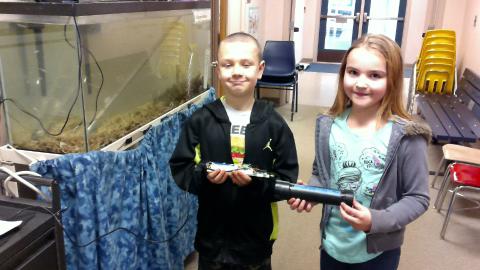Sand Hill Elementary School

It is important to the students and the teachers to have a tank that closely matches the environment in which the salmon are going to be released.
Each year, Third Graders in Amy Radtke-Cowsert's classes at Sand Hill Elementary School in Belfair, Washington raise Fall Chum Salmon to release into Sweetwater Creek. Amy has been involved involved in the Olympic STEM Pathways Partnership (OSPP) for the past three years and submitted this story about their OSPP project.
Sand Hill Elementary is in a rural setting and has about 63.5% free and reduced lunch. The salmon are brought from the hatchery as eggs in January and are released into the creek in April. As the salmon eggs develop and become alevin, then fry the students observe the process and monitor the tank. The students use a thermometer to measure temperature and water testing strips to monitor pH, chlorine, and nitrates in the tank on a weekly basis. It is important to the students and the teachers to have a tank that closely matches the environment in which the salmon are going to be released. The tank has large and small gravel, branches, and a continuous flow of water. The survival rate for the salmon in the Sand Hill tank is almost 100% and the students attend a field trip to release the salmon into Sweetwater Creek at the Theler Wetlands.
This year the students and I were wondering how the tank water compared to the creek water and if there were any changes in the tank water when we weren’t at the tank observing and testing the water. Therefore, the students and I decided to use the temperature sensor to monitor the tank at school and in Sweetwater Creek in order to have a better idea of how the environments match. The temperature sensor was placed in the salmon tank for two days before the salmon fry were released then in Sweetwater Creek for two days ending on the day the salmon were released to the creek. We were surprised to see that the temperature in our tank and the temperature in the creek matched very closely, even though the air temperatures were very different.
We concluded that we are keeping the temperature in the tank consistent with the salmon’s natural environment. In the future, we would like to see if we are as closely matching the dissolved oxygen and nitrate levels in the tank and the creek. In order to accomplish this we would need to add different sensors to our Pyboard.








